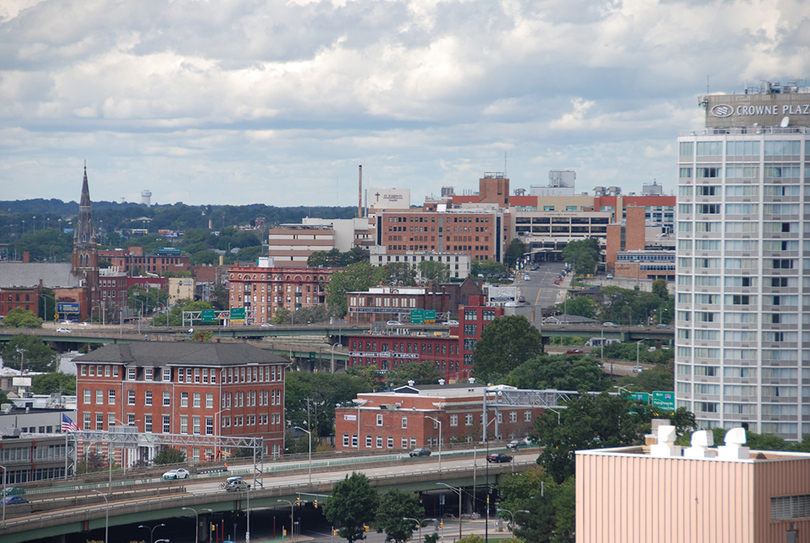For Syracuse activists, Gillibrand’s new gun trafficking legislation is overdue

Lucy Messineo-Witt | Photo Editor
Activists in Syracuse said that Sen. Kirsten Gillibrand's new gun trafficking legislation, Hadiya Pendleton and Nyasia Pryear-Yard Gun Trafficking & Crime Prevention Act, was a step in the right direction but long overdue.
Get the latest Syracuse news delivered right to your inbox.
Subscribe to our newsletter here.
When Sen. Kirsten Gillibrand, D-N.Y., announced new federal gun trafficking legislation in Syracuse last week, Clifford Ryan said it was overdue.
The proposed legislation, which Gillibrand unveiled on Sept. 24 at Seals Community Center on Syracuse’s Southside, would make it a federal crime to traffic guns across state lines. It would also create penalties for people “who knowingly ship, transport or transfer firearms to an individual not legally allowed to possess a gun,” according to a statement published by Gillibrand’s office.
Ryan, who is an anti-gun violence activist and founder of OG’s Against Violence, said the legislation’s introduction was a welcome step forward, but he couldn’t believe how long it has taken to advance a federal anti-gun trafficking bill.
“I was surprised that it took all this time for them to actually put a federal law in place,” Ryan said. “All of these guns have been coming into the community for years, and years, and years. And they never had federal laws to address this.”
Gillibrand’s legislation — titled the Hadiya Pendleton and Nyasia Pryear-Yard Gun Trafficking & Crime Prevention Act — would bolster law enforcement and prosecutors’ ability to crack down on people involved in trafficking guns across state lines.
About 60% of recovered guns used in crimes in Syracuse originated out-of-state, according to a report from the New York attorney general’s office.
Joining Gillibrand at the announcement were Syracuse Mayor Ben Walsh and Common Council President Helen Hudson, among other community leaders.
Hudson said she’s seen more than 500 of her neighbors lose their lives as a result of gun violence in the city, WRVO reported. She tied the steady flow of guns into the city to the “Iron Pipeline” — the underground trafficking network that moves illegal firearms northward along the I-95 corridor and into New York state.
Stopping the movement of guns into Syracuse is critical to reducing gun violence in the city, Ryan said — especially since few guns involved in shootings in the city originated in Syracuse.
Gillibrand expressed confidence that the bill could pass, noting that the last time it was introduced in the Senate, it received 58 of the 60 votes required to avoid a filibuster. Bipartisan support, she said, will hopefully overcome the gap.
The announcement came as Syracuse is on pace to nearly match or outpace the number of shooting deaths it saw in 2020. So far this year, 16 residents have been killed by gunfire, compared to 19 in all of 2020, according to data provided by the Syracuse Police Department.
Also in 2021, the city has seen 451 “shots fired” incidents and 88 people injured by gunfire.
This year, SPD’s recently-disbanded Gun Violence Suppression Detail recovered 36 illegal guns and made 62 gun-related arrests, SPD spokesperson Sgt. Matthew Malinowski said in an email to The Daily Orange. In 2020, the unit, which was dedicated to proactively countering gun violence in the city, recovered 19 guns and made 35 arrests, Malinowski said.
On Sunday — less than a week after Gillibrand’s announcement — police and firefighters responded to another shooting on the Southside, less than a mile from the Syracuse University campus, syracuse.com reported.
Gillibrand’s proposed legislation is a welcome step toward reducing gun violence but will need to be part of a much larger solution, said Hasan Stephens, an anti-gun violence activist and founder of the Good Life Youth Foundation.
“This is a multi-pronged, multifaceted approach that needs to be taken,” Stephens said.
Stephens’ foundation serves at-risk youth in the city of Syracuse, providing services and programs with the goal of reducing cycles of poverty and incarceration. It’s these cycles, Stephens said, that contribute to gun violence in Syracuse and across the country.

For that reason, increasing penalties on interstate gun traffickers alone won’t be enough, Stephens said. Real change will require a sizable investment in underserved communities to address the effects of systemic racism and to bolster community organizations, such as Good Life Youth Foundation, that can intervene before violence takes place.
Ryan echoed the need for local, community-based solutions in addition to federal action.
“The other side is making sure that we’re investing resources into historically resource-deficient areas,” Stephens said. “If we’re not willing to make an investment into these communities, then we can’t expect these youth to actually have things to deter them from the life that they’re engaging in.”
To Stephens and Ryan, that means more community engagement with local youth, as well as the creation of new safe spaces and programs to keep kids “off the street.”
All of those goals, Stephens said, will need local and state-level action. Gillibrand’s legislation, if passed, can only do so much.




